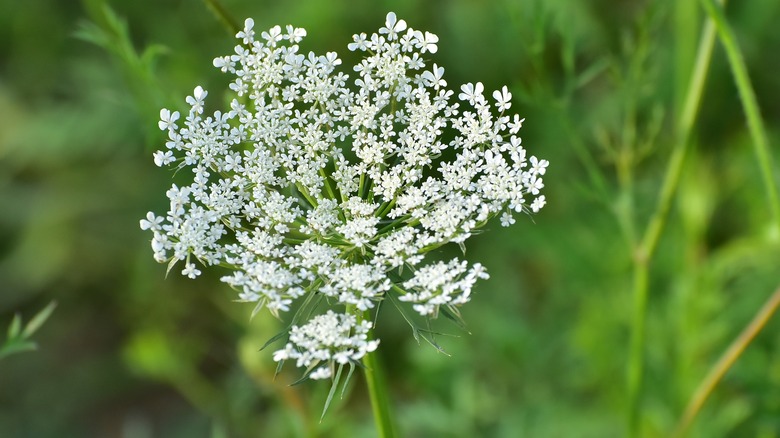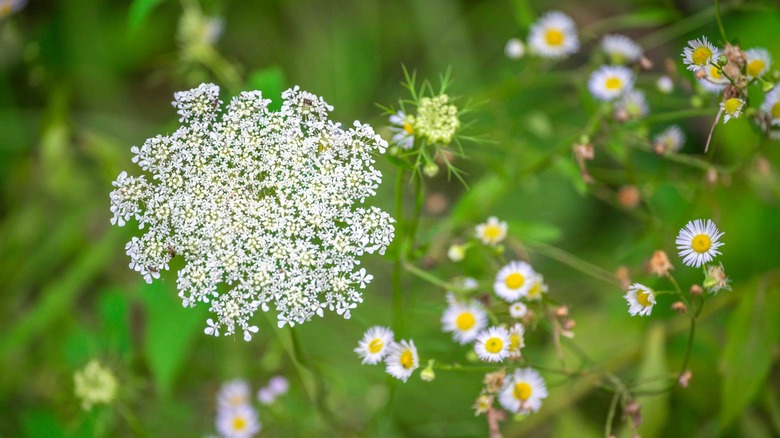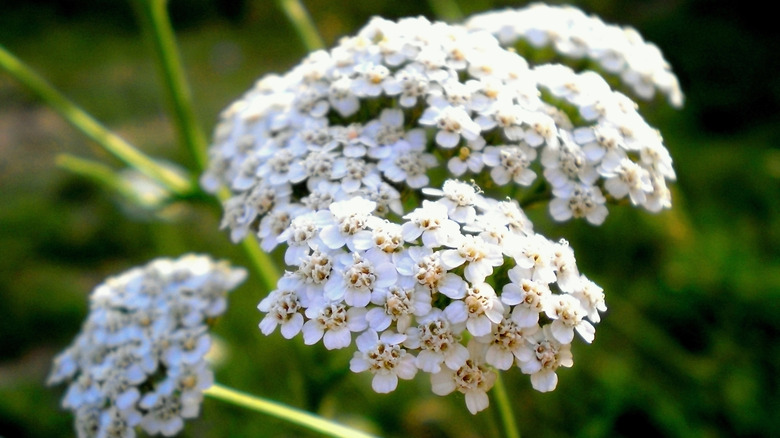How Dangerous Is Queen Anne's Lace? Here Are The Uncomfortable Details
Fields of Queen Anne's lace waving in the wind make for an elegant sight, but unfortunately, these beautiful flowers can be harmful to both gardeners and native habitats. They are an invasive species and considered a noxious weed in most states. Additionally, the University of Minnesota Extension states that the sap from the plant can potentially cause a skin reaction called phytophotodermatitis, which can result in the development of redness and blisters after sun exposure. Despite its beauty, you may want to think about removing this quick-spreading flower if you find it growing in your yard. Luckily there is no shortage of beautiful non-invasive substitutes you can plant in its place.
Native to Europe, Queen Anne's lace (Daucus carota) is the wild relative of carrots and is sometimes referred to as wild carrot. But it has several extremely toxic look-alikes, including giant hogweed, which is a dangerous supersized weed that can cause severe blistering and skin damage. Another extremely dangerous plant that can be mistaken for Queen Anne's lace is hemlock. The confusion between all these plants is understandable as they are all part of the larger Apiaceae family. Considering how many members of this family are toxic and how similar many of them look, it's advised that amateur foragers avoid all members of the Apiaceae family.
Eradicating Queen Anne's lace
Queen Anne's lace isn't just potentially a problem for your skin, it can also cause issues for native plant species. Because it matures quickly, Queen Anne's lace can grow successfully in a variety of soils and conditions and can overtake many slower growing native plants. This is especially a problem in undisturbed areas like the sides of roads.
Queen Anne's lace is a biennial, meaning it has a two year life cycle. In the first year it only grows leaves, then in the second year it flowers, sets seeds, and dies. Because one plant can produce up to 40,000 seeds it's essential to eradicate Queen Anne's lace before it flowers. Regularly mowing or pulling up young Queen Anne's lace plants can keep this invasive species from spreading in your garden. Be sure to wear gloves though and check with your local department of conservation if you aren't sure if you're dealing with Queen Anne's lace or one of its more dangerous look-alikes. Queen Anne's lace often declines as native grasses move into an area, so planting something like switchgrass may also be beneficial to eradicating Queen Anne's lace.
Queen Anne's lace substitutes for the garden
Considering how pretty Queen Anne's lace flowers are in gardens and bouquets, it's unfortunate that it is so invasive. Luckily, there are plenty of beautiful flowers with similar shapes and colors. Ammi (Ammi majus), another member of the Apiaceae family, is an excellent substitute for Queen Anne's lace. An excellent summer annual in zones 2 through 11, it boasts a similar flower shape to Queen Anne's lace and is popular with pollinators, but unlike Queen Anne's lace, it is not invasive. Gardeners with pets and young children should be aware that its leaves are considered mildly toxic, per NC State Extension.
Yarrow (Achillea millefolium) is another good option for gardeners looking to replace Queen Anne's lace with a noninvasive option. Native to North America, Europe, and Asia, yarrow grows well in zones 3 through 9 and is a great choice for cut flowers and pollinator gardens. It is surprisingly easy to grow and take care of yarrow, thanks to its drought and heat-tolerant nature. It can be mildly toxic to cats and dogs though, according to the University of California, so pet owners should use caution. Another beautiful option for gardeners looking for elegant white flowers is diamond frost euphorbia. While it is only perennial in zones 10 through 12, it grows quickly enough to be used as an annual in most areas and has a distinctive flower shape that is sure to impress in the garden.


